Commentary: Ethiopia should democratize its multinational federalism and properly implement its constitution, not amend it

By Bizuneh Yimenu @BizunehYimenu
Addis Abeba – Since Prime Minister Abiy Ahmed seized power in 2018 through popular anti-government protests, the ideology of imperial Ethiopia has been revitalized, and the debate regarding the very desirability of Ethiopia’s multinational federalism has become blistering. In this piece, I will unpack this very polarized issue by discussing why Ethiopia chose the current multinational federalism, the contentious issues and why some of these contentions are fallacious based on theory and other states’ experiences.
Why federalism in the first place?
Ethiopian state-building was based on the domination and subjugation of nations and nationalities under the Imperial and the Derg regimes. Under imperial rule, diversity was seen as a sin and crushed to expand the hegemonic culture, language, and political thinking.
The Derg allowed some cultural pluralism, yet it refused to allow self-rule and political liberalization. This gave birth to armed forces demanding self-determination of nations and the eventual coming to power of the EPRDF regime in 1991. When EPRDF, led by the TPLF, seized power, it was expected to address the question of how Ethiopia can deal with diversity, considering the problems of the past, the burdens of the present and the challenges of the future.
EPRDF and other forces realized that a multinational federal system was the only way to manage diversity and hold together the country that was on the verge of disintegration. Hence, the country underwent a four-year transition period to craft a federal constitution and adopted a federal system that grants self-determination, including and up to secession. Though the country registered economic growth under the EPRDF, the system lacked democracy, and the federal system became a facade. Since Abiy came to power, attempts to reverse the federal system have been galvanized.
Ethiopia’s identity-based federalism: why contentious?
Ethiopia’s constitution does not mention that the country follows “ethnic federalism”, a term the detractors of Ethiopian federalism often prefer to use, which eventually became a common terminology in the Ethiopian federalism literature. The constitution’s preamble states, ‘We, the Nations, Nationalities and Peoples of Ethiopia”, indicating that the Ethiopian federation is a voluntary union formed by the nations, nationalities and peoples. The constitution also declares that, “all sovereign power resides in the Nations, Nationalities and Peoples of Ethiopia”, and they have the right to self-determination, including secession.
“Accommodation, self-rule and self-determination were the demands of not just the TPLF but also the Oromo, Somali, Sidama, Benishangul-Gumuz and Afar people’s liberation fronts”
These provisions are the foundation of the Ethiopian federation and the main glue that held the country from trying to tear itself apart. But these provisions have been the most contentious clauses. Detractors of Ethiopian federalism argue that they were crafted by the TPLF to enable it to rule the country following ethnic fault-lines. Indeed, the TPLF’s role in the federal design is undeniable. Nevertheless, claiming these rights were imposed by one political force is too simplistic. The lack of such rights compelled different identity-based forces to start armed struggle in the early 1970s. Accommodation, self-rule and self-determination were the demands of not just the TPLF but also the Oromo, Somali, Sidama, Benishangul-Gumuz and Afar people’s liberation fronts. They are only just-rights of nations and nationalities earned after many sacrifices.
Accommodation of diversity is often linked to the right to self-determination, which entails representative democracy and representative government. Indeed, such rights are part of the international convention. Article 1(1) of the Covenant on Civil and Political Rights states all peoples have the right to self-determination. Under that right, nations are entitled to freely determine their political status and pursue economic, social and cultural development. Undeniably, the right to self-determination might not be preferable for non-territorial minorities because they cannot enjoy the political dimension of self-determination and territorial self-rule as they may not possess a homeland.
Nevertheless, the Covenant states that non-territorial minorities ‘‘shall not be denied the right, in community with the other members of their group, to enjoy their own culture, to profess and practice their own religion, or to use their own language”. In the context of the current Ethiopian federalism, for example, Amhara in Oromia are entitled to practice their religion and culture and use their language. Practically this is happening in most of the Ethiopian regions. There are thousands of schools in Oromia offering education in Amharic. Similarly, almost all regions in Ethiopia teach at least two Ethiopian languages. Oromia towns bordering Afar, Gambella, Sidama, Somali and Benishagul-Gumuz have schools teaching children whose mother tongue is other than Afaan Oromoo. The same is true in Gambella and Benishangul Gumuz as well. Going further, Harari adopted two working languages considering the region’s population-an approach that Addis Abeba should follow to accommodate the demands of the Oromo.
Ethiopia is not unique in this case. Federations such as Belgium and Switzerland followed different approaches to protect minorities and accommodate language demands within the multinational federal framework. For instance, Switzerland has four federal languages – German, French, Italian and Romansch – a lesson Ethiopia should learn.
The issue of non-territorial regional minorities
What is missing in Ethiopia is, however, the representation of non-territorial minorities in regional and sub-regional decision-making. Under article 52 of the federal constitution, regions are authorized to exercise their powers to ‘advance self-government, a democratic order based on the rule of law’. Regions can address this issue by utilizing their constitutional space and enacting laws. So far, most regions have focused on ensuring the representation of territorial minorities and no region has made serious attempts to enhance non-territorial minorities’ representation in regional decision-making. However, such limitation does not warrant reversing the hardly earned self-determination rights of nations and nationalities. Indeed, such an idea is against the primary principle of democracy-majority rule and minority right. Ethiopia must ensure that human, democratic and political rights enshrined under the federal constitution are dully implemented from the federal to the local government level.
The debate regarding the desirability of identity-based federalism is not unique to Ethiopia. Globally, such debates increased after the failure of the most prominent federations, such as the former Soviet Union, Czechoslovakia and Yugoslavia. Taking these federations as evidence, the detractors of Ethiopian federalism raise two primary concerns.
Federalism: a platform to secession?
The first concern is the ‘federalism slippery slope’: creating identity-based regions empowers regional leaders to challenge the central state and sustain an effective secessionist bid.
“It is vital to note that the internal territorial design of the Ethiopian federation is not purely identity-based. Article 45 (1) of the constitution declares that regions shall be delimited based on the settlement patterns, language, identity and consent of the peoples concerned“
These claims are illogical for different reasons. First, using the disintegration of the three (the Soviet Union, Czechoslovakia and Yugoslavia) non-democratic, super-centralized, and non-democratic socialist federations is inaccurate because they were sham federations. Second, the success of identity-based federalism is much higher than the failures. For instance, Belgium, Canada, India, Nigeria, Russia, South Africa, and Switzerland are successful federations and they, to a certain degree, considered identity in redrawing their constituent units. Indeed, these countries adopted federalism to address identity-based (ethnic/racial/cultural/religious) political demands.
It is vital to note that the internal territorial design of the Ethiopian federation is not purely identity-based. Article 45 (1) of the constitution declares that regions shall be delimited based on the settlement patterns, language, identity and consent of the peoples concerned. Practically, seven of its eleven regions have three or more territorial-based nationalities. For instance, there are about 50 nationalities in SNNP, 6 in Amhara, 5 in Benishangul-Gumuz, 5 in the South West Ethiopian Peoples region, 4 in Gambella, and 3 in Tigray. This shows that factors other than identity, such as administrative convenience and historical bond, were considered in redrawing regional boundaries. For instance, the South West Ethiopia Peoples region was born out of a referendum based on the consent of the peoples concerned as the people in the area felt that it was administratively more convenient for them to secede for Southern Nations Nationalities and Peoples’ Region.
Critics of identity-based federalism provide geographic federalism as an alternative, which is irrelevant to the problems of managing relations among territorial ethno-nationalities. Geographic federalism is not a cure for the problems the states with territorial ethno-nationalities face; it might be a solution for something else, such as administrative inefficiency caused by large territorial size. Some countries (including Ethiopia) that adopted multinational federalism have failed unitary systems and opted for identity-based federalism as a practical alternative to accommodate deep-rooted diversity.
Federalism: A recipe to inter-group violence?
The second concern critics of Ethiopian federalism advance is that it fuels inter-group conflict, a debate not confined to Ethiopia. Studies suggest that allowing self-rule ‘can play an important constructive role in mediating relations between different communities in multi0ethnic states’. Considering the challenges of multinational state like Ethiopia face in managing diversity, with all its challenges, sub-national autonomy has no alternative. This is because self-rule reduces conflict by promoting integration and enabling diverse groups to live together and shape their common vision.
Similarly, the fear regarding regional autonomy being a springboard to secession is rarely justified. Instead, often it is the refusal to federalize, rather than federalism itself, that stimulates secession. Although federalism is not a panacea for all political problems multi-ethnic states face, it is inaccurate to argue that it promotes secessionism. Studies reveal that no violent separatist movement has ever succeeded in a federal democracy. This means federalism will be effective in managing diversity if the system is complemented by democracy, a key ingredient missing in Ethiopian federalism.
It is vital to note that all multinational democracies, for example, Belgium, Canada, India, and Switzerland, are all federal and remain stable despite problems. Evidence shows that if diverse countries want to become stable democracies, they must design a pragmatic federal order to ensure diversity management and citizens’ equality.
When federalism was introduced in 1991, both hope and uncertainties followed. Some anticipated democracy and genuine self-rule, while others feared disintegration. So far, both views are not entirely accurate because federalism neither resolved inter-ethnic conflicts totally nor Ethiopia has disintegrated as speculated. But the country has suffered since 2015 and, more prominently, post-2019. The federal system worked reasonably well until the EPRDF, the main glue holding the federation together, dissolved.
Flawed Features of Ethiopian Federalism
The dissolution of the EPRDF and the political crises that gave birth to civil war exposes that Ethiopian federalism is flawed due to three main problems.
One, the system hinges on the party. Every party crisis has transformed into a governance crisis, revealing that party politics hugely influence the federation’s operation. The way out is untying state and party. Abiy Ahmed promised to draw a line between state and party when assuming power. Nevertheless, that has not been realized yet. The party decides the day-to-day operation of the system, often surpassing the constitution on important matters. This necessitates institutions that restrain the incumbent.
“Genuine federalism requires some regional autonomy to enable sub-national governments to address region-specific demands such as language issues and representation of regional minorities in decision-making“
Two, the system lacks regional autonomy and respect for the constitutional division of powers. For instance, one of the problems the country is facing is ethnic-based violence could be solved by allowing the regions to operate autonomously and utilize their constitutional space to accommodate non-territorial regional minorities. Ethiopia’s problem is not federalism but the absence of genuine federalism and its ingredients. Genuine federalism requires some regional autonomy to enable sub-national governments to address region-specific demands such as language issues and representation of regional minorities in decision-making.
Three, the lack of democratic elections, because of the incumbents’ lack of political will and the opposition fragmentation, affected the prospects of democratizing the federation. Democratization helps maintain a delicate balance between the demands of territorial and non-territorial groups.
To sum up, Ethiopia’s federalism was only a response to legitimate grievances and a powerful force on the ground. However, the system should be supplemented by processes to boost inter-ethnic harmony and protect and accommodate regional minorities. Efforts to accommodate regional minorities should be enhanced without compromising the majority’s rights. On top of this, democratizing the country will help to address competing and conflicting demands peacefully. Centralization or suppression cannot help to address identity-based demands, but self-rule and democratization can. Ethiopia’s current problem is neither the constitution nor its federal system but a failure to implement the constitution adequately. The constitution includes the universal human right principle, which should be appropriately implemented. AS
___________________________________________________________________//___________________________________________________________________
Editor’s Note: Dr Bizuneh Getachew Yimenu is a Teaching Fellow at the School of Government of Birmingham University. He earned his PhD in Comparative Politics at the University of Kent. Bizuneh worked as an Assistant Lecturer and Subject Tutor from 2017-2022 at the University of Kent. Before joining Kent, he completed an MA and BA at Addis Abeba University, Ethiopia. He also worked as a Lecturer at Dilla University, Ambo University and Ethiopian Civil Service University in Ethiopia between 2008 and 2017. He tweets @BizunehYimenu








